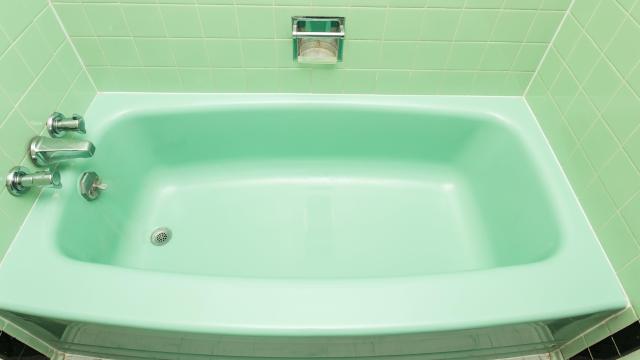Whether you have a century-old, freestanding clawfoot model, a colourful midcentury drop-in, or something more modern, your bathtub probably takes up a good portion of your bathroom. Even if you don’t take baths regularly (and if that’s the case, why not?), you still are spending a lot of time in its vicinity.
But over time, your tub may have chipped in one or more places. Not only does that make it feel rough to the touch, but if left for a long time, the chip can get bigger and more serious. Fortunately, fixing a chip in your bathtub is something you can do yourself. Here’s what to know.
How to fix a chip in your bathtub
While you can fix a chip in your bathtub, you should also keep in mind that you probably won’t get it to perfectly match the rest of the tub, either in terms of colour, sheen, or both. But it will look better and, most importantly, make the tub safer and more comfortable to use. Here’s how to do it:
Find the right repair kit
When fixing a chipped bathtub yourself, your best bet is a two-compound epoxy kit with a catalyst and a hardener. If you know what your tub is made of (i.e. porcelain, fibreglass, plastic, etc.) you can get a kit specific for that material. Or, you can get one that works for a variety of materials. Also, find a kit that comes the closest to matching the colour of your tub.
Clean the area
In order for the epoxy to adhere to your tub, the area needs to clean — free from dead skin, soap scum, and any other gunk that has built up. Start by scrubbing the spot with a cleanser like dish soap or detergent, degreaser, or something with a bit of grit, like Bar Keepers Friend. Follow that up by wiping the area with rubbing alcohol or acetone to get rid of any remaining residue. Finally, dry it with a lint-free cloth.
Mix the epoxy
Follow the directions on your repair kit and mix the epoxy compounds. If the kit doesn’t come with a disposable tray and mixing tool, be sure to use something you don’t ruining (like a piece of cardboard, a plastic throw-away plate, etc). The kit likely contains enough of each compound to make multiple repairs, so don’t use it all at once.
Apply the epoxy
First, use painters’ tape to section off the area you’re going to repair. Then apply a thin layer to the chip using a plastic knife or paintbrush. Spreading it towards one side rather that both ensures the epoxy is covering the chip evenly.
Let that layer dry
It typically takes between three and five hours for a layer of epoxy to dry, but if possible, leave it for 24 hours so you know it’s set. After it has dried, the epoxy should be as hard as the tub itself.
Sand the spot
Now that the chip has been filled and the epoxy has dried, it’s time to smooth it out. First, spray the area with some water, then use ultra-fine sandpaper to taper the edges of the repair so it blends in with the rest of the tub. Keep both the tub and sandpaper wet as you work. When you’re done, determine whether the chip needs another layer of epoxy. If so, repeat the steps above.

Leave a Reply
You must be logged in to post a comment.